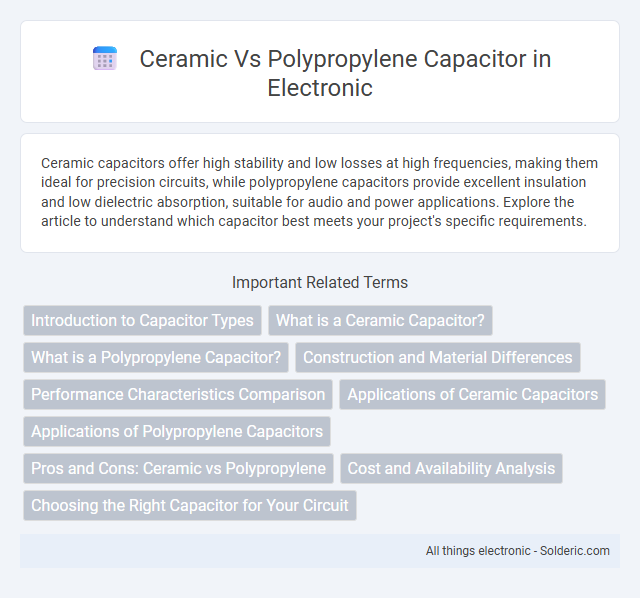Ceramic capacitors offer high stability and low losses at high frequencies, making them ideal for precision circuits, while polypropylene capacitors provide excellent insulation and low dielectric absorption, suitable for audio and power applications. Explore the article to understand which capacitor best meets your project's specific requirements.
Comparison Table
| Feature | Ceramic Capacitor | Polypropylene Capacitor |
|---|---|---|
| Dielectric Material | Ceramic (various formulations) | Polypropylene (PP) film |
| Capacitance Range | 1 pF to 100 uF | 0.001 uF to 10 uF |
| Voltage Rating | Up to 50 kV (depending on type) | Up to 1000 V (typically 100-630 V) |
| Tolerance | +-1% to +-20% | +-1% to +-5% |
| Temperature Stability | Moderate to high (depending on ceramic class) | Excellent (low loss, stable across wide temperature range) |
| ESR (Equivalent Series Resistance) | Moderate | Very low |
| Frequency Response | Good up to MHz range | Excellent for high-frequency applications |
| Applications | General purpose, decoupling, filtering, RF circuits | Precision timing, filtering, audio, high-frequency circuits |
| Cost | Low | Higher |
| Size | Small, compact | Larger than ceramic capacitors for same capacitance |
| Reliability | Good, but can crack mechanically | High, stable with long lifespan |
Introduction to Capacitor Types
Ceramic capacitors feature a ceramic dielectric material known for high stability, low losses, and excellent frequency response, making them ideal for RF and high-frequency applications. Polypropylene capacitors use a polypropylene film dielectric, providing superior insulation resistance, low dielectric absorption, and high voltage handling, suitable for precision filtering and audio circuits. Each type offers distinct advantages, with ceramic capacitors excelling in compactness and cost-effectiveness, while polypropylene capacitors deliver enhanced performance in stability and reliability under high voltage conditions.
What is a Ceramic Capacitor?
A ceramic capacitor is a non-polarized electronic component that uses a ceramic material as its dielectric, offering high stability and low losses for high-frequency applications. You'll find ceramic capacitors commonly used in filtering, coupling, and decoupling circuits due to their small size and reliability. Compared to polypropylene capacitors, ceramics excel in compact designs but may have lower capacitance accuracy and higher temperature coefficients.
What is a Polypropylene Capacitor?
A polypropylene capacitor is a type of film capacitor made from polypropylene plastic film as the dielectric, known for its low dielectric loss, high insulation resistance, and excellent stability over a wide frequency range. This capacitor offers superior performance in applications requiring low distortion and high precision, such as audio equipment, signal filtering, and timing circuits. Compared to ceramic capacitors, polypropylene capacitors exhibit better temperature stability and lower electrical noise, making them ideal for high-frequency and AC applications.
Construction and Material Differences
Ceramic capacitors consist of ceramic dielectric materials layered between metal electrodes, which provide high stability and low losses, making them suitable for high-frequency applications. Polypropylene capacitors use polypropylene film as the dielectric, known for excellent insulation properties and high voltage endurance, resulting in superior performance in audio and precision filtering circuits. The structural differences significantly impact their electrical characteristics, with ceramic capacitors offering compact size and cost efficiency, while polypropylene capacitors provide lower dielectric absorption and higher reliability under stress.
Performance Characteristics Comparison
Ceramic capacitors offer low equivalent series resistance (ESR) and excellent high-frequency performance, making them ideal for filtering and RF applications. Polypropylene capacitors provide superior stability, low dielectric absorption, and low dissipation factor, ensuring precise performance in audio and timing circuits. Choosing between these depends on your specific needs for frequency response, temperature stability, and tolerance requirements.
Applications of Ceramic Capacitors
Ceramic capacitors are widely used in high-frequency applications such as RF circuits, filters, and decoupling due to their low equivalent series resistance (ESR) and stability over a broad temperature range. Their small size and excellent insulation properties make them ideal for surface-mount technology in consumer electronics, automotive systems, and medical devices. Unlike polypropylene capacitors, which excel in high-voltage and audio applications, ceramic capacitors are preferred for compact, high-frequency, and high-capacitance designs.
Applications of Polypropylene Capacitors
Polypropylene capacitors are widely used in high-frequency circuits, precision timing applications, and audio equipment due to their low dielectric loss and excellent stability. Their superior insulation resistance and low dissipation factor make them ideal for filter circuits, coupling, and decoupling applications in power electronics and signal processing. Compared to ceramic capacitors, polypropylene capacitors offer enhanced performance in environments requiring high voltage handling and minimal distortion.
Pros and Cons: Ceramic vs Polypropylene
Ceramic capacitors offer high capacitance in a small size, excellent frequency response, and low cost but have a higher dielectric absorption and microphonic effect, which can affect signal quality in precision circuits. Polypropylene capacitors provide superior stability, low dielectric loss, and excellent voltage handling, making them ideal for high-frequency and audio applications, though they tend to be bulkier and more expensive. Your choice depends on the balance between size, cost, and performance requirements for your specific electronic design.
Cost and Availability Analysis
Ceramic capacitors generally offer lower costs and higher availability due to widespread manufacturing and extensive use in consumer electronics, making them a cost-effective choice for mass production. Polypropylene capacitors, while pricier, provide superior performance in high-frequency and precision applications, but their limited production scale results in reduced availability and higher lead times. Cost-efficiency and availability make ceramic capacitors preferable for budget-sensitive projects, whereas polypropylene capacitors are selected for specialized, high-reliability circuits despite increased expense.
Choosing the Right Capacitor for Your Circuit
Ceramic capacitors offer low equivalent series resistance (ESR) and high-frequency performance, making them ideal for decoupling and filtering in high-speed circuits, while polypropylene capacitors provide superior stability, low dielectric absorption, and low losses suitable for audio, precision timing, and high-voltage applications. Selecting the right capacitor depends on factors such as operating frequency, voltage rating, temperature stability, and signal integrity requirements. For circuits demanding high precision and minimal distortion, polypropylene capacitors excel, whereas ceramic capacitors are preferred for compact, cost-effective solutions in general-purpose electronic designs.
Ceramic vs polypropylene capacitor Infographic

 solderic.com
solderic.com